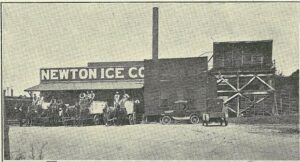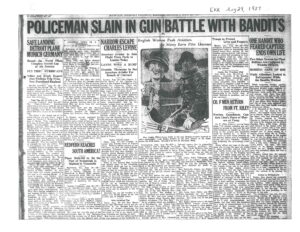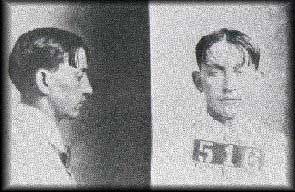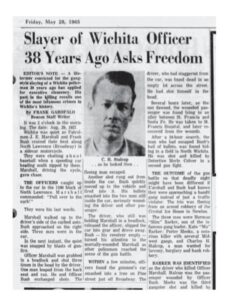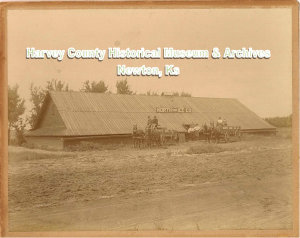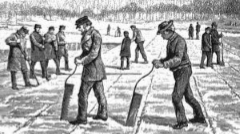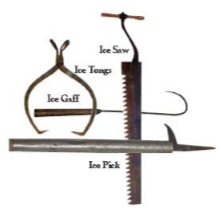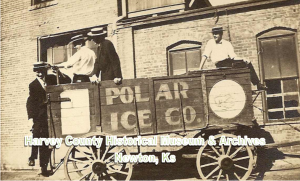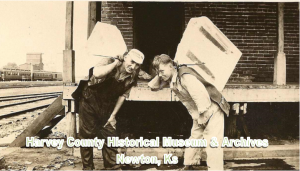by Kristine Schmucker, HCHM Archivist/Curator
“Stick’em up!”
Engineer Raymond Moulds was working alone in the early morning hours of August 29, 1927 at the Newton Ice Co. on Oak Street. His coworker, Tillman Reiff, had left to check on the Sand Creek plant, but Moulds thought nothing of it as he worked in the engine room. The Kansan describes what happened next.
“At about 12:45 am he was startled by the appearance of a stranger, who made his entrance through a side door. Pulling an automatic pistol, the man . . . commanded, “Stick’em up!” Moulds obeyed. The man was unmasked short, and wore a dark suit.”
Two other men were with the first. They each held a revolver and were masked.
“What should we do with him?” asked one of the gunmen.
“Get rid of him.” commanded the other who was six feet tall and seemed to be in charge.
The first man then shoved his revolver into Moulds’ back and took him to the large ice storage vault at the front of the building and locked him in. Meanwhile the other two broke into the safe in the office. Moulds sat in the locked chamber with the temperature at 29′ for about an hour until he could no longer hear the pounding. He pried open the door with a crowbar and ran to Main street to alert police.
It was discovered that about $200 worth of silver, cash and checks had been taken from the Ice Co safe.
Further investigation revealed that robbers had stolen a sledgehammer and hand saw from Fent’s Blacksmith Shop on east 6th Newton. Used, no doubt, to break through the safe.
Harvey County Sheriff J.M. McIntire then notified the police in surrounding towns.
“Gun Battle with Bandits”
Sheriff McIntire soon heard of a terrible “gun battle with bandits” in Wichita that had occurred shortly after the robbery at Newton. Hoping there might be a connection he contacted the Wichita police.
The tragic details were told.
Early in the morning, on north St. Francis, Wichita, police Officer J. E. Marshall and his partner Frank Bush had stopped a Chevrolet sedan containing three men. As the officers drew near, the men in the car began to fire, shooting Officer Marshall twice through the head. Officer Bush returned fire as two of the men in the car sped away and one man ran on foot.
A chase ensued and ended when the car finally served into a ditch. One man left the car, drew his pistol and shot himself in the head. The second man in the car ran but was soon found. A man hunt continued for the third man.
It was soon revealed that the man that took his own life was Herman Barker, one of the infamous “Bloody Barkers.”
Never Taken Alive!
Herman was the oldest of the Barker brothers whose mother, “Ma Barker,” oversaw the activities of the gang. Throughout the 1920s and 30s, the outlaw gang of brothers and allies actively kidnapped people, and robbed banks and post offices. That August night in 1927, Herman Barker was the first of the family to die a violent death. Herman had once bragged that he would never be taken alive. He was 33 years old.
A second man, Charlie Stalcup, was arrested at dawn. The third man, Myers also known as Elmer A Inman was on the run until August 31, when he was shot and killed. There was confusion about his identity because at first Stalcup would not identify him as the third man. Finally, he agreed, “Yes, that’s him” after looking at his picture, only his name was not Myers or Inman. He was identified as a man named Porter Meeks who was on parole from Oklahoma where he had been sentenced to 25 years for a bank robbery on December 31, 1914.
Amidst the tragedy, the people of Newton and Wichita found a way to help support the widow of Officer Marshall establishing a fund to pay the mortgage of her home.
“Sole Survivor”
Charles Stalcup, “the sole survivor of a trio which engaged Marshall and . . .Bush in a gun battle” stood trial for the murder of Officer J.E. Marshall in November 1927. The jury selection took a long time with the defense exercising seven challenges and the state three. The first day more than forty men were considered for the jury. Stalcup’s own father, I.H. Stalcup, from Picher, OK, was one of the defense attorneys. Despite the slow start the case went to the jury in a few days.
Stalcup was found guilty of first-degree murder after the jury deliberated for three hours. Life was the mandatory sentence for first degree murder. Despite his appeal for a new trial, Stalcup was sent to Lansing Penitentiary for life. Thirty-eight years later he was paroled. Stalcup, the “sole survivor” who left a mark on Newton’s history and was part “of one of Wichita’s most infamous crimes” died in Little Rock, AR, December 1981.
Sources
- Evening Kansan Republican: 29 August 1927; 30 August 1927; 31 August 1927.
- Emporia Gazette: 01 November 1927, 05 November 1927 14 November 1927.
- Council Grove Reporter: 05 November 1927, 11 November 1927.
- Hutchinson News Herald: 31 August 1927, 31 October 1927.
- Newton City Directory: 1919-1920
- “Herman Barker” Find A Grave.
- “Charles H. Stalcup” Find A Grave.
- https://www.briannica.comhttps://biography/Ma-Barker, 14 June 2024


